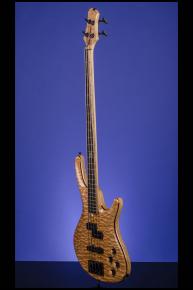A Quite Spectacular Bass
2013 Roscoe Century Signature 4 String Bass
Built by Master Luthier, Keith Roscoe in 2013, this exceptionally beautiful bass weighs just 8.70 lbs. Offset asymmetrical double cutaway, contoured solid 'Swamp Ash' body with a remarkable 'Exhibition Quilt' Maple top and back. The body is 14 inches wide and just under 1 3/4 inches deep. 'Sandwiched' between the maple top and the ash body is a one eighth inch layer of Wenge Accent Veneer, and sandwiched between the maple back and the ash body is a very thin veneer of Purpleheart. Nine-piece flamed maple neck with a scale length of 34 inches, a nut width of just over 1 5/8 inches and a wonderful and very fast medium profile. The nine-piece neck is comprised of a wide center of Purpleheart surrounded by layers of Maple, Wenge and Purpleheart. 'Very Striking Brazilian' Rosewood fretboard with 24 original medium-jumbo frets, an abalone inlaid pearl 'Bass Clef' marker at the twelfth fret and small inlaid abalone side-dot markers, and a hand-carved graphite nut. Headstock with quilted maple veneer on face and back, over a thin layer of Purpleheart. Headstock face with "Keith B. Roscoe" decal in black and inlaid abalone "R" at top. Back of headstock with oval black decal "Made in USA" and serial number "6470" written in black marker. Individual black Hipshot HB6 bass tuners with key shaped buttons. Bolt-on neck secured by four screws. One Seymour Duncan Antiquity II P[recision] eight-pole split pickup in the neck position and one Seymour Duncan Antiquity II J[azz] eight-pole pickup in the bridge position with outputs of 9.80k and 8.44k respectively. Four controls (two volume, two tone controls). Custom Roscoe Purpleheart control knobs with quilted maple tops. Recessed jack input on lower treble side of body. Roscoe combined bridge/tailpiece with four individually adjustable saddles. This wonderful playing and sounding bass has hardly ever been played and is in mint (9.50) condition. It features one of the most striking 'two-tone' Brazilian Rosewood fretboards that we have ever seen. Housed in it's original Roscoe three-latch, rectangular hardshell case with black leather ends and black plush lining (9.50). Complete with the original Roscoe 'specification sheet', truss-rod and bridge saddle adjustment allen keys, four alternative control knobs (black metal with ribbed sides) and allen keys, two spare strap buttons and case key.
Keith Roscoe's Mission: To build the best electric guitars and basses possible, using the best available materials and the best craftsmanship possible.
Keith Roscoe set up his Greensboro, North Caroline shop and started building guitars in 1983. “After you’ve repaired or restored 10,000 guitars, you start thinking, ‘I could build these myself.’” His first guitars were mostly Telecaster copies, but he soon began experimenting with drop top bodies, which did really well. “We eventually began making basses, although it was somewhere around 20 guitars to every one bass.” Soon, however, it got to be ten guitars to every one bass. Encouraged, Roscoe made some significant alterations to his bass design in the late ’90s and that very year came home from the winter NAMM show with a lot of bass orders. In the end, bass orders began to outweigh guitar orders, so much so that by 2000 Roscoe stopped building guitars altogether and focused just on basses. Roscoe basses sport strikingly beautiful contours and— from the beginning—graphite-reinforced necks. “This type of reinforcement makes our necks stiffer,” Keith explains. “You also have a higher resonance frequency, so less chance for dead spots or boom tones, and it makes the neck generally more reliable.” Roscoe Guitars’ location provided some of the impetus for tweaking Fender’s neck design, as did his experience as a repairman. In North Carolina, where humidity and temperature swings abound, players would bring in their basses at least twice a year for neck adjustments. “To this day, I design and build guitars based on the idea that an instrument should be easy to maintain and fix.” Keith attributes much of their early success to generating production basses with this kind of reliability. Understanding the sonic qualities of wood remains most important to Keith, as it does for many luthiers, and he insists that the evolution of every bass begins with the wood that he selects and purchases himself. In fact, Roscoe argues that he can hear the sound of a bass from the moment he begins working with the raw lumber. “When you run a piece of swamp ash through a joiner, it sounds different than when you do the same with mahogany. For example, when a piece of wood sounds edgy in a machine, I find it sounds edgy in the bass.” As such, Keith and his employees begin listening for the sonic properties of each bass from the moment it undergoes its first cut, and they continue doing so until it receives its final coat of finish. “I listen to the bass from the very beginning to the very end,” he says. (Rod Taylor. Keith Roscoe of Roscoe Guitars. Bass Player, October 31, 2012).













